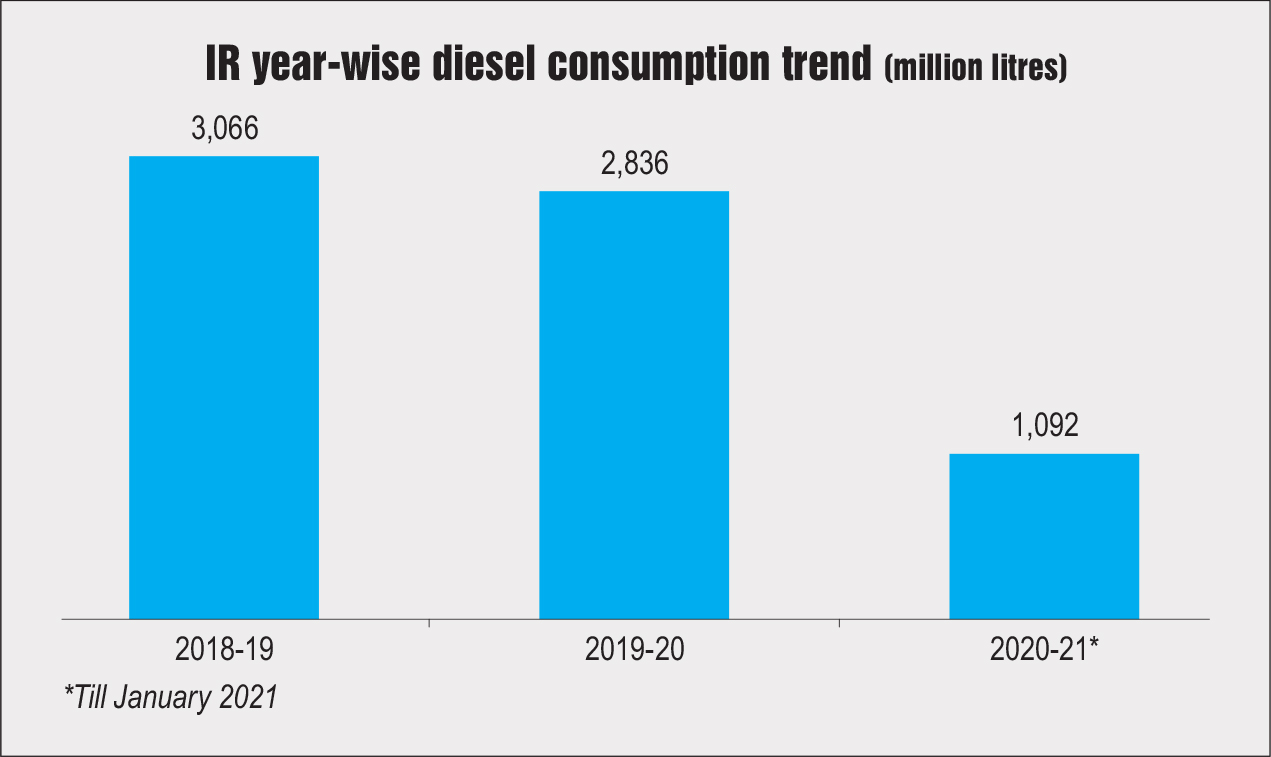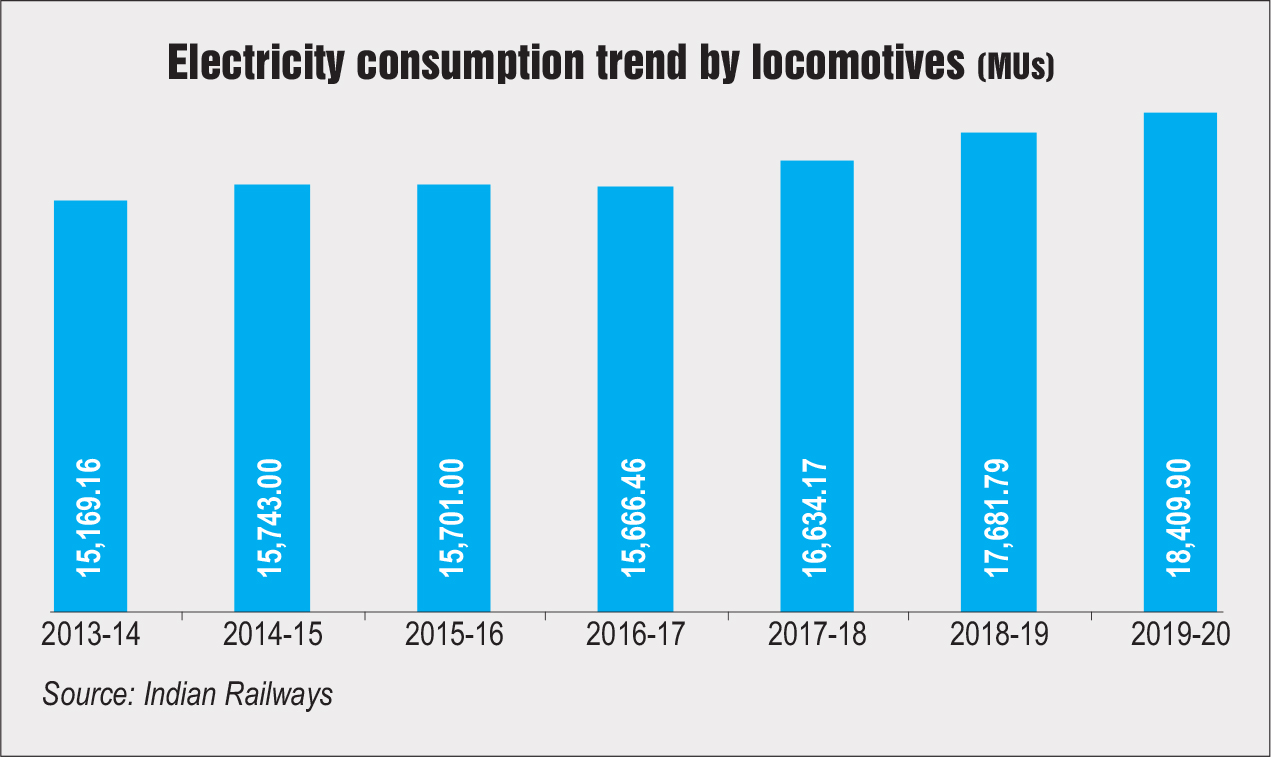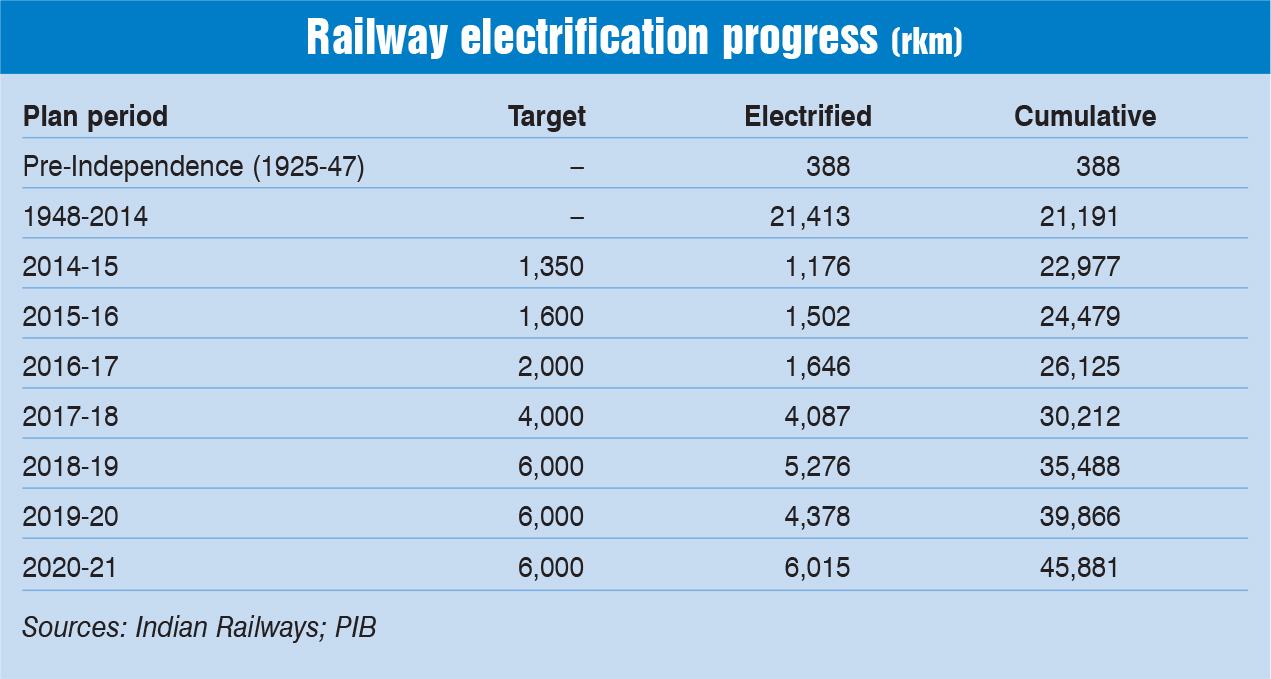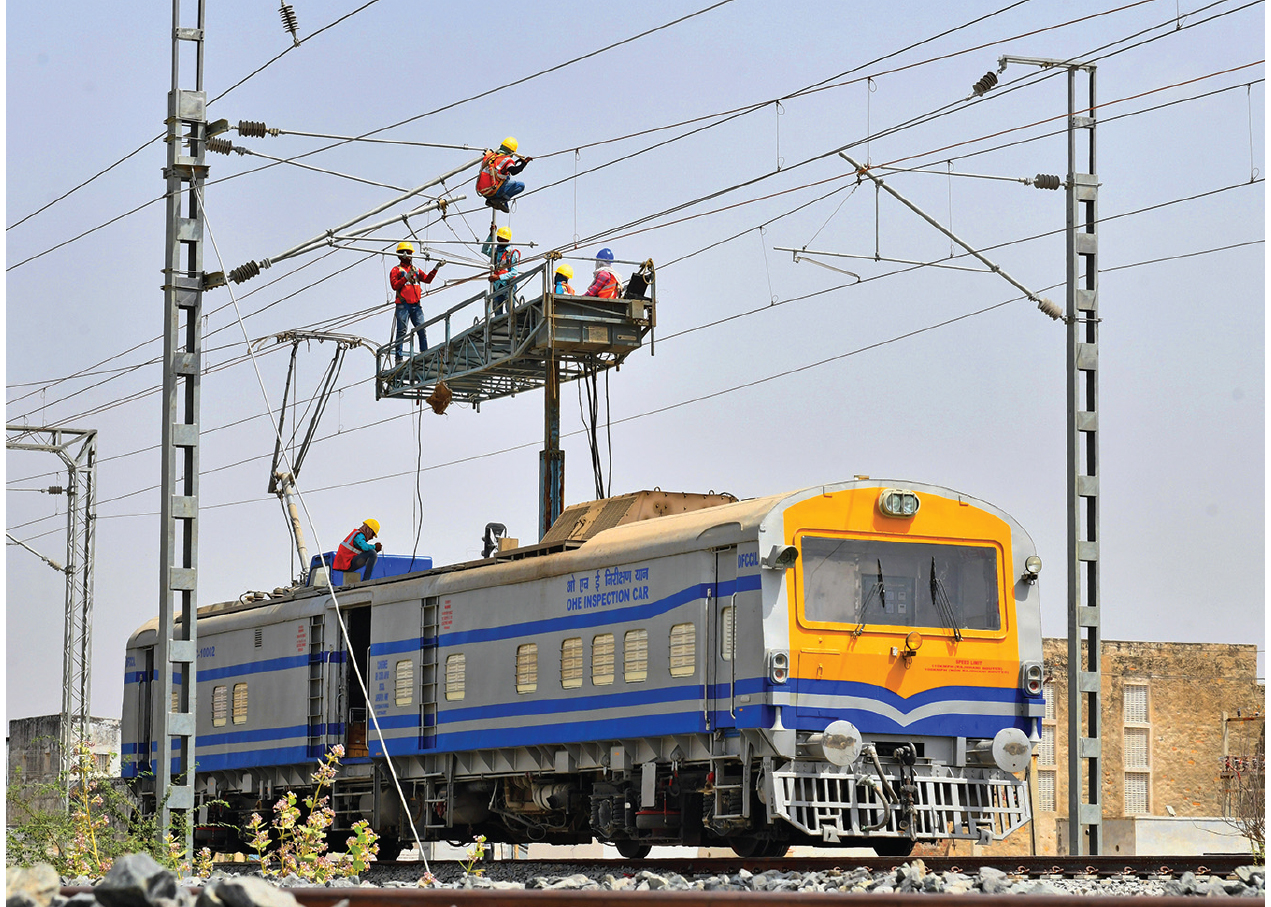
On a sunny afternoon, the roofs at New Delhi railway station can be seen gleaming brightly. A closer look reveals that this is owing to the solar panels installed on the roofs. Therein lies the symbol of a quiet revolution that is under way across Indian Railways (IR).
IR is a major consumer of electricity. It is estimated to have consumed 14.1 billion units (BUs) of electricity in 2020-21. While this was somewhat lower than the 18.4 BUs consumed in 2019-20, owing to the reduced railway services last year on account of the Covid-19 lockdowns, the railways are expected to bounce back with renewed vigour, given that they are the central vein passing through the entire country.
Focus on renewable energy
IR is increasingly adopting solar energy in its operations. It is taking noteworthy measures to reduce its carbon footprint and fuel cost, in line with its objective to becoming a net-zero carbon emissions organisation by 2030.
IR has already installed 111 MW worth of solar panels on the rooftops of over 1,000 stations and around 400 service buildings, as of January 2021. It has also issued tenders for another 198 MW of capacity at 550 railway stations. It is estimated that IR has the potential to install about 20 GW of solar power capacity. About 3,450 MW of ground-mounted solar capacity is currently under implementation. IR also plans to set up a one-of-a-kind solar plus storage hybrid pilot project at Dahod in Gujarat, connected to the railway traction network.
IR owns 477,000 hectares of land, which is 22 per cent more land than the state of Goa. According to IR, 51,000 hectares, that is, 10.8 per cent of this land, could be used for installing solar panels. Therefore, setting up solar plants on railway land is a huge opportunity and could prove to be a new source of revenue, besides meeting electricity demand in a sustainable manner.
In a bid to incentivise private sector participation to meet this target, IR has made provisions for letters of credit (LoCs) in case of payment default by the railways and has incorporated a penalty in the model bidding document for solar power for delayed payments.
IR also has wind energy installations across the country, including a 56.4 MW wind project in Maharashtra, a 21 MW (2×10.5) wind project in Tamil Nadu and a 26 MW wind project in Rajasthan.
 Railway network electrification
Railway network electrification
During 2021-21, the Mumbai-Howrah route, known to be one of the busiest routes in the country, was fully electrified. This was one of the lines out of the 6,015 route km (rkm) electrified in 2020-21. Notably, it was in 2020-21 that railway electrification took place at the fastest pace. Over the coming year or two several lines are expected to be electrified to upgrade India’s railway network, thereby reducing its diesel dependence, aiding in raising average speeds and reducing emissions substantially. Overall, during the 2014-21 period, IR electrified 24,000 rkm, which is impressive, in contrast to 21,413 rkm of railway electrification carried out from 1948 to 2014. In aggregate, around 45,000 rkm or 71 per cent is already electrified out of the total network length of 63,949 rkm. Another 18,800 rkm remains to be electrified by December 2023.
In 2019-20, 43 per cent of the passenger traffic operated on diesel locomotives, while the remaining 57 per cent operated on electric traction. From an empirical point of view, this is a sharp reversal of trend compared to 2000-01, the component of diesel consumption in the passenger division stood at 56.1 per cent whereas the quantum of electric traction stood at 43.9 per cent. In freight, electric traction accounted for 64.7 per cent of the traffic in 2019-20 against 56.5 per cent in 2000-01, while diesel consumption in locomotives dedicated to freight movement stood at 35.3 per cent in 2019-20, sharply declining by 8.2 per cent compared to 2000-01.
The electrification of the network will help IR divert diesel consumption to other sectors, in addition to being more cost efficient. In 2020-21, IR’s diesel consumption stood at 1.43 billion litres vis-à-vis 2.8 billion litres in 2019-20 and 3.06 billion litres in 2018-19. It is estimated that 3.7 million tonnes of CO2 emissions was prevented by the reduction in diesel consumption during 2020-21.
Railway electrification is hugely advantageous for IR because it will reduce its energy bill, given that the per unit cost of electricity is significantly lower than the per unit cost of diesel. According to the Ministry of Railways, electrification will lead to a reduced carbon footprint for IR as the environmental cost per kilometre for electric traction is 1.50 paise against 5.10 paise for diesel traction. At 100 per cent electrification, IR’s energy bill savings are estimated to be over Rs 145 billion annually.
Over the coming years, IR’s electricity consumption is set to witness substantial growth with IR planning to electrify its entire network by December 2023. IR ambitiously envisages becoming net carbon-neutral by 2030, by eliminating its diesel dependence and through other sustainability initiatives.
 Energy efficiency initiatives
Energy efficiency initiatives
IR is exploring and installing innovative technologies and management techniques to further conserve energy and reduce its carbon footprint. Switching to direct supply from overhead power equipment to carriages, using energy efficient equipment for AC carriages and maintaining temperatures at 24-26 degrees Celsius will help it conserve energy. IR also introduced the real-time information system (RTIS) in 2,700 electric locomotives, which will facilitate real-time tracking of trains and their operational parameters.
Electric engines are being re-engineered and manufactured in India to use higher horsepower, particularly 12,000 HP, and containers are being switched to double stack. When these come into use, trains can average over 50 kmph speeds as opposed to the current 25 kmph. There will be fewer hold-ups through better signalling. Besides, longer trains reduce costs with a faster turnaround of cargo.
IR is undertaking optimisation of energy demand through initiatives such as retrofitting of head-on generation systems in locomotives, installation of 100 per cent LED lights and high star-rated appliances, undertaking energy audits, implementing smart metering, conversion of diesel locos to electric locos, increase in the production of electric locomotives, performance-based contracting for production of high-powered locomotives and the deployment of energy efficient rakes. Further, IR has completely switched over to the production of energy efficient three-phase electric locomotives with regenerative features, with a provision for regenerating electric energy while braking, with the regenerative energy being fed back to the grid. Loco pilots are being regularly counselled on use of regenerative feature and to switch off the blower in case yard detention is over 15 minutes.
 In addition, trailing locomotives of a train carrying light load are switched off to save energy in the case of multi-units. Energy consumption is regularly monitored through microprocessor-based energy meters provided in all the electric locomotives. Also, 269 energy efficient electric multiple unit rakes with three-phase insulated gate bipolar transistors propulsion systems have been introduced in the Mumbai suburban area, with regenerative braking feature that helps in saving energy.
In addition, trailing locomotives of a train carrying light load are switched off to save energy in the case of multi-units. Energy consumption is regularly monitored through microprocessor-based energy meters provided in all the electric locomotives. Also, 269 energy efficient electric multiple unit rakes with three-phase insulated gate bipolar transistors propulsion systems have been introduced in the Mumbai suburban area, with regenerative braking feature that helps in saving energy.
Recently, IR invited bids to develop hydrogen fuel cell-based technology that can be used to upgrade existing diesel-powered trains. The project entails retrofitting diesel electric multiple unit (DEMU) on the 89 km Sonepat-Jind section with hydrogen cells. Under the project, two DEMU rakes will be converted at first to use hydrogen as fuel. An allocation of Rs 80 million has been set aside for this phase in the current year. Subsequently, two hybrid narrow gauge locomotives will be retrofitted with hydrogen fuel cell power movement.
IR is actively embracing digitalisation of its assets, layering them with technologies such as asset management, signalling, as well as improved customer services. These technologies will improve the efficiency of capacity usage by reducing idling time and improving predictability in services, which will reduce the energy intensity of IR.
 The way forward
The way forward
IR is rapidly evolving into a more sophisticated organisation and over the upcoming years it expects to unlock its hidden potential to the fullest extent through its two-pronged investment in solarisation as well as electrification. Additionally, its investment in other efficiency enhancing measures is bound to yield significant results in optimising its energy usage.
IR’s focus on solar panel installation, improved average speeds across the network, declining diesel usage and emissions are expected to enhance its profitability, efficiency and reliability throughout the network. Considering that the railways are a keystone of Indian infrastructure, it is undeniable that the evolution of IR will empower India towards reaching a new dimension of development.
